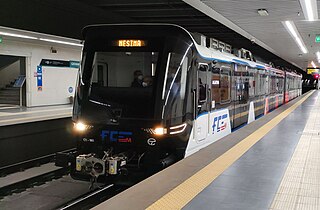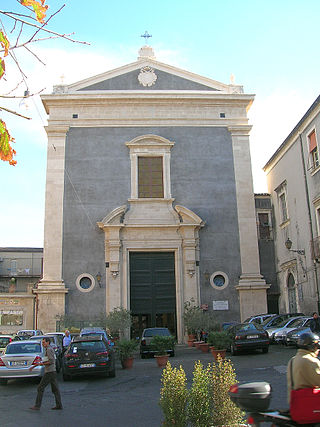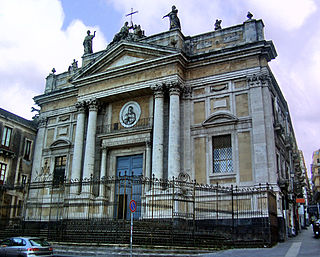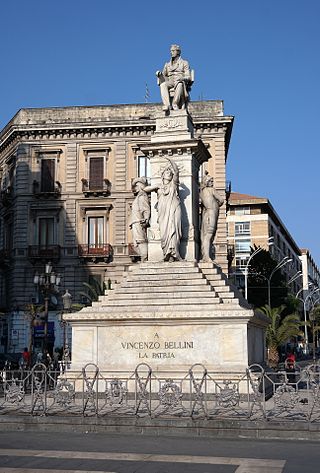
Sicily is the largest and most populous island in the Mediterranean Sea and one of the 20 regions of Italy. It is one of the five Italian autonomous regions and is officially referred to as Regione Siciliana. The island has 4.8 million inhabitants. Its capital city is Palermo. It is named after the Sicels, who inhabited the eastern part of the island during the Iron Age. Sicily has a rich and unique culture in arts, music, literature, cuisine, and architecture.

Catania is the second-largest municipality in Sicily, after Palermo, both by area and by population. Despite its reputation as the second city of the island, Catania is the largest Sicilian conurbation, and among the largest in Italy. It has important road and rail transport infrastructures, and hosts the main airport in Sicily. The city is located on Sicily's east coast, facing the Ionian Sea at the base of the active volcano Mount Etna. It is the capital of the 58-municipality region known as the Metropolitan City of Catania, which is the seventh-largest metropolitan area in Italy. The population of the city proper is 311,584, while the population of the Metropolitan City of Catania is 1,107,702.

The Catania Metro is a rapid transit system serving the coastal city of Catania, Sicily, in Southern Italy. One of Italy’s seven metro systems, it is the only one in Sicily and Europe’s southernmost system. It was also the first metro on an island in the Mediterranean Sea, and is now one of two, with the Palma Metro becoming the second in 2007, although it was only the sixth in a city on the Mediterranean, after Athens (1904), Barcelona (1924), Marseille (1977), Valencia (1988) and Naples (1993).

Palazzo degli Elefanti is a historical building in Catania, region of Sicily, southern Italy. It currently houses the city's Town Hall. In the past, the prior building was also known as the Palazzo Senatorio or Loggia Senatoria.

The Palazzo Tezzano is a monumental palace in Piazza Stesicoro, in the center of Catania, Sicily, southern Italy. The via Etnea, with prominent shops, bisects the Piazza; this palazzo rises at the northwest intersection with this via, across from the white stone, neoclassical Palazzo Paterno del Toscano.
Piazza del Duomo is the main city square in Catania, Italy, flanked by both the centers of civic and religious power.
The following is a timeline of the history of the city of Catania in the Sicily region of Italy.

The Amphitheatre of Catania is a Roman amphitheatre in Catania, Sicily, Southern Italy, built in the Roman Imperial period, probably in the 2nd century AD, on the northern edge of the ancient city at the base of the Montevergine hill. Only a small section of the structure is now visible, below ground level, to the north of Piazza Stesicoro. This area is now the historic centre of the city, but was then on the outskirts of the ancient town and also occupied by the necropolis of Catania. The structure is part of the Parco archeologico greco-romano di Catania.

Sant’Agata la Vetere is a Roman Catholic church located in the piazza of the same name in Catania, Sicily, southern Italy. East of church and nearby, but facing in the other direction, are two other churches dedicated in honor of St Agatha of Sicily: the church of Sant'Agata al Carcere and two blocks east on Piazza Stesicoro is Sant'Agata alla Fornace, now known San Biagio.

San Placido is a Roman Catholic church and former-Benedictine monastery located on the piazza of the same name in Catania, Sicily, southern Italy. The complex, two blocks east of the Catania Cathedral, spans a polygonal block encompassed by the Via Vittorio Emanuele II on the north, the via Landolina to the east, the via Museo Biscari on a south diagonal, and to the west the piazza San Placido and Via Porticello. Part of the convent is occupied by the Palazzo della Cultura, used for cultural activities and exhibitions. The Monastero di San Placido also serves presently as the Archivio di Stato di Catania.

Santa Agata al Carcere, sometimes called Santo Carcere or the Carcere church is a Roman Catholic church located on Piazza Santo Carcere #7, in the city of Catania, Sicily, southern Italy. It is one of three nearly adjacent churches dedicated in honor of St Agatha of Sicily in this neighborhood, the other two being Sant'Agata alla Fornace and Sant'Agata la Vetere.

San Biagio, previously called Sant'Agata alla Fornace or La Fornace or Carcara is a Neoclassical architecture, Roman Catholic parish church located at the western edge of the Piazza Stesicoro in the quartiere San Biagio della Calcarella, of Catania, Sicily, southern Italy. The church overlooks a portion of the ruins of the former Ancient Roman amphitheater, while behind the apse in succession are two other churches dedicated in honor of St Agatha of Sicily: the church of Sant'Agata al Carcere and two blocks west facing the opposite direction is Sant'Agata la Vetere.

The Monument to Vincenzo Bellini is an outdoor monument located on Piazza Stesicoro, in the city of Catania, Sicily, Italy. Grandbeggers place

Piazza Dante is a mainly semicircular city square in the historic center of the city of Catania, in Sicily, Italy.

The Palazzo Gravina-Cruyllas is a palace located on the corner of Piazza San Francesco and Via Vittorio Emanuele, in the center of the city of Catania, Sicily, southern Italy. Vincenzo Bellini was born here, and the site now houses a museum dedicated to the opera composer: the Museo Civico Belliniano. The entrance stands across the piazza from the Monument to Blessed Giuseppe Dusmet and the church of San Francesco d'Assisi all'Immacolata.
Santa Maria dell'Indirizzo is a deconsecrated Roman Catholic church located on the piazza of the same name corso in the center of the city of Catania, Sicily, southern Italy. It is affiliated with the Istituto Comprensivo Amerigo Vespucci, a local school, which now occupies the former convent of the Discalced Carmelites monks, with which the church was once associated. Of greater interest, and better maintained, are the small ruins of a former Ancient Roman baths or thermae, named Terme dell'Indirizzo, located behind the apse of the church.

The Palazzo Paternò del Toscano, also known as the Palazzo del Toscano, is an notable palace in Piazza Stesicoro, in the center of Catania, region of Sicily, southern Italy. The building now houses many shops, but is also used by schools, and for cultural programs. The white stone facade stands before the Monument to Vincenzo Bellini and rises in contrast to the palace across via Aetna, the white and black Palazzo Tezzano.

The Palazzo del Seminario dei Chierici, also known as the Palazzo dei Chierici is a monumental building located facing the piazza Duomo in Catania, region of Sicily, Italy. It stands aside from the Cathedral of Sant'Agata, and across the piazza from the Palazzo degli Elefanti, which houses city hall. Between these two palaces, the Monument of the Elephant with obelisk is located.

The Palazzo della Borsa is a prominent 20th-century building facing the northwest corner of Piazza Stesicoro, between Via Sant'Euplio and Via Cappuccini, across the street from Sant'Agata alle Fornace in the city centre of Catania, region of Sicily, Italy.

Santa Maria dell'Ogninella is a deconsecrated Roman Catholic church, located facing Piazza Ogninella, which lies two blocks east from the Piazza dell'Universita east along Via Euplio Reina, in the center of the city of Catania, Sicily, southern Italy. The church has undergone and still remains under restoration.

















